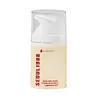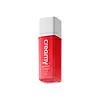What's inside
What's inside
 Key Ingredients
Key Ingredients

 Benefits
Benefits

 Concerns
Concerns

 Ingredients Side-by-side
Ingredients Side-by-side

Water
Skin ConditioningCetyl Ethylhexanoate
EmollientGlycerin
HumectantButylene Glycol
Humectant1,2-Hexanediol
Skin ConditioningNiacinamide
SmoothingPropanediol
SolventAmmonium Acryloyldimethyltaurate/Vp Copolymer
Carbomer
Emulsion StabilisingTromethamine
BufferingSodium Acrylate/Sodium Acryloyldimethyl Taurate Copolymer
Emulsion StabilisingPolyisobutene
Caprylic/Capric Triglyceride
MaskingLactobacillus
Skin ConditioningLactobacillus/Rice Ferment
Skin ConditioningLactobacillus/Soybean Ferment Extract
Skin ConditioningMacadamia Ternifolia Seed Oil
EmollientSaccharomyces/Coix Lacryma-Jobi Ma-Yuen Seed Ferment Filtrate
Skin ConditioningSaccharomyces/Potato Extract Ferment Filtrate
HumectantXanthan Gum
EmulsifyingHydrogenated Lecithin
EmulsifyingDisodium EDTA
Ethylhexylglycerin
Skin ConditioningAllantoin
Skin ConditioningCaprylyl Glycol
EmollientAdenosine
Skin ConditioningGlyceryl Acrylate/Acrylic Acid Copolymer
HumectantCaprylyl/Capryl Glucoside
CleansingCholesterol
EmollientPolyglyceryl-10 Oleate
Skin ConditioningSorbitan Oleate
EmulsifyingBrassica Campestris Sterols
EmollientPhytosteryl/Behenyl/Octyldodecyl Lauroyl Glutamate
Skin ConditioningRetinal
Skin ConditioningSilica
AbrasiveAluminum/Magnesium Hydroxide Stearate
Emulsion StabilisingTocopherol
AntioxidantPotassium Cetyl Phosphate
EmulsifyingPentaerythrityl Tetra-Di-T-Butyl Hydroxyhydrocinnamate
AntioxidantArctium Lappa Root Extract
Skin ConditioningCnidium Officinale Root Extract
Skin ConditioningDioscorea Japonica Root Extract
Skin ConditioningPaeonia Suffruticosa Root Extract
Skin ProtectingRehmannia Chinensis Root Extract
Skin Conditioning3-O-Ethyl Ascorbic Acid
Skin ConditioningBakuchiol
AntimicrobialSh-Oligopeptide-1
Skin ConditioningSh-Oligopeptide-2
Skin ConditioningSh-Polypeptide-1
Skin ConditioningWater, Cetyl Ethylhexanoate, Glycerin, Butylene Glycol, 1,2-Hexanediol, Niacinamide, Propanediol, Ammonium Acryloyldimethyltaurate/Vp Copolymer, Carbomer, Tromethamine, Sodium Acrylate/Sodium Acryloyldimethyl Taurate Copolymer, Polyisobutene, Caprylic/Capric Triglyceride, Lactobacillus, Lactobacillus/Rice Ferment, Lactobacillus/Soybean Ferment Extract, Macadamia Ternifolia Seed Oil, Saccharomyces/Coix Lacryma-Jobi Ma-Yuen Seed Ferment Filtrate, Saccharomyces/Potato Extract Ferment Filtrate, Xanthan Gum, Hydrogenated Lecithin, Disodium EDTA, Ethylhexylglycerin, Allantoin, Caprylyl Glycol, Adenosine, Glyceryl Acrylate/Acrylic Acid Copolymer, Caprylyl/Capryl Glucoside, Cholesterol, Polyglyceryl-10 Oleate, Sorbitan Oleate, Brassica Campestris Sterols, Phytosteryl/Behenyl/Octyldodecyl Lauroyl Glutamate, Retinal, Silica, Aluminum/Magnesium Hydroxide Stearate, Tocopherol, Potassium Cetyl Phosphate, Pentaerythrityl Tetra-Di-T-Butyl Hydroxyhydrocinnamate, Arctium Lappa Root Extract, Cnidium Officinale Root Extract, Dioscorea Japonica Root Extract, Paeonia Suffruticosa Root Extract, Rehmannia Chinensis Root Extract, 3-O-Ethyl Ascorbic Acid, Bakuchiol, Sh-Oligopeptide-1, Sh-Oligopeptide-2, Sh-Polypeptide-1
Water
Skin ConditioningDisodium EDTA
Hydroxyethyl Ethylcellulose
EmulsifyingSodium Acrylates Copolymer
Lecithin
EmollientGlycerin
HumectantXanthan Gum
EmulsifyingTocopherol
AntioxidantBHT
AntioxidantCaprylic/Capric Triglyceride
MaskingPhenoxyethanol
PreservativeEthylhexylglycerin
Skin ConditioningPropanediol
SolventCamellia Sinensis Leaf Extract
AntimicrobialAlthaea Rosea Flower Extract
Skin ConditioningPentylene Glycol
Skin ConditioningLevulinic Acid
PerfumingGlyceryl Caprylate
EmollientGluconolactone
Skin ConditioningCellulose
AbsorbentRetinal
Skin ConditioningTriethanolamine
BufferingWater, Disodium EDTA, Hydroxyethyl Ethylcellulose, Sodium Acrylates Copolymer, Lecithin, Glycerin, Xanthan Gum, Tocopherol, BHT, Caprylic/Capric Triglyceride, Phenoxyethanol, Ethylhexylglycerin, Propanediol, Camellia Sinensis Leaf Extract, Althaea Rosea Flower Extract, Pentylene Glycol, Levulinic Acid, Glyceryl Caprylate, Gluconolactone, Cellulose, Retinal, Triethanolamine
 Reviews
Reviews

Ingredients Explained
These ingredients are found in both products.
Ingredients higher up in an ingredient list are typically present in a larger amount.
This ingredient is an emollient, solvent, and texture enhancer. It is considered a skin-softener by helping the skin prevent moisture loss.
It helps thicken a product's formula and makes it easier to spread by dissolving clumping compounds.
Caprylic Triglyceride is made by combining glycerin with coconut oil, forming a clear liquid.
While there is an assumption Caprylic Triglyceride can clog pores due to it being derived from coconut oil, there is no research supporting this.
Learn more about Caprylic/Capric TriglycerideDisodium EDTA plays a role in making products more stable by aiding other preservatives.
It is a chelating agent, meaning it neutralizes metal ions that may be found in a product.
Disodium EDTA is a salt of edetic acid and is found to be safe in cosmetic ingredients.
Learn more about Disodium EDTAEthylhexylglycerin (we can't pronounce this either) is commonly used as a preservative and skin softener. It is derived from glyceryl.
You might see Ethylhexylglycerin often paired with other preservatives such as phenoxyethanol. Ethylhexylglycerin has been found to increase the effectiveness of these other preservatives.
Glycerin is already naturally found in your skin. It helps moisturize and protect your skin.
A study from 2016 found glycerin to be more effective as a humectant than AHAs and hyaluronic acid.
As a humectant, it helps the skin stay hydrated by pulling moisture to your skin. The low molecular weight of glycerin allows it to pull moisture into the deeper layers of your skin.
Hydrated skin improves your skin barrier; Your skin barrier helps protect against irritants and bacteria.
Glycerin has also been found to have antimicrobial and antiviral properties. Due to these properties, glycerin is often used in wound and burn treatments.
In cosmetics, glycerin is usually derived from plants such as soybean or palm. However, it can also be sourced from animals, such as tallow or animal fat.
This ingredient is organic, colorless, odorless, and non-toxic.
Glycerin is the name for this ingredient in American English. British English uses Glycerol/Glycerine.
Learn more about GlycerinPropanediol is an all-star ingredient. It softens, hydrates, and smooths the skin.
It’s often used to:
Propanediol is not likely to cause sensitivity and considered safe to use. It is derived from corn or petroleum with a clear color and no scent.
Learn more about PropanediolRetinal is a form of retinoid. Retinoids are the gold-standard class of anti-aging ingredients.
Retinal has many benefits as other retinoids: improve skin texture, reduce large pores, reduce the effects of aging, reduce the visibility of dark spots, heal scars, and fight acne.
Studies show retinal may work at a faster rate than retinol due to its structure.
All retinoids have to be converted into retinoic acid before starting to work. Some retinoids take several steps of conversion before binding. Retinal is only one step away, making it more potent.
Like other retinoids, retinal may be irritating. It is best to ease into using this ingredient frequently.
Using the 'ramp up' method, start by using retinol once a week. This gives your skin time to adjust and decrease irritation. Once you feel ready, you can slowly increase the frequency of retinol use.
Using retinoids will increase sun-sensitivity in the first few weeks of use. Though studies show retinoids increase your skin's natural SPF with continuous use, it is best to always wear sunscreen and sun-protection.
Learn more about RetinalTocopherol (also known as Vitamin E) is a common antioxidant used to help protect the skin from free-radicals and strengthen the skin barrier. It's also fat soluble - this means our skin is great at absorbing it.
Vitamin E also helps keep your natural skin lipids healthy. Your lipid skin barrier naturally consists of lipids, ceramides, and fatty acids. Vitamin E offers extra protection for your skin’s lipid barrier, keeping your skin healthy and nourished.
Another benefit is a bit of UV protection. Vitamin E helps reduce the damage caused by UVB rays. (It should not replace your sunscreen). Combining it with Vitamin C can decrease sunburned cells and hyperpigmentation after UV exposure.
You might have noticed Vitamin E + C often paired together. This is because it is great at stabilizing Vitamin C. Using the two together helps increase the effectiveness of both ingredients.
There are often claims that Vitamin E can reduce/prevent scarring, but these claims haven't been confirmed by scientific research.
Learn more about TocopherolWater. It's the most common cosmetic ingredient of all. You'll usually see it at the top of ingredient lists, meaning that it makes up the largest part of the product.
So why is it so popular? Water most often acts as a solvent - this means that it helps dissolve other ingredients into the formulation.
You'll also recognize water as that liquid we all need to stay alive. If you see this, drink a glass of water. Stay hydrated!
Learn more about WaterXanthan gum is used as a stabilizer and thickener within cosmetic products. It helps give products a sticky, thick feeling - preventing them from being too runny.
On the technical side of things, xanthan gum is a polysaccharide - a combination consisting of multiple sugar molecules bonded together.
Xanthan gum is a pretty common and great ingredient. It is a natural, non-toxic, non-irritating ingredient that is also commonly used in food products.
Learn more about Xanthan Gum